Watering indoor plants can be tricky, especially if you’re trying to keep your home clean and tidy. Without the right approach, it’s easy to spill water, soak floors, and make a mess that’s difficult to clean up. Learning how to water indoor plants without making a mess is essential to keep both your plants and your home in top shape. By following a few simple tips and techniques, you can ensure your plants get the hydration they need without creating unnecessary work for yourself. Let’s explore the best ways to keep your indoor garden thriving without the stress of spills.
The Common Struggles of Watering Indoor Plants
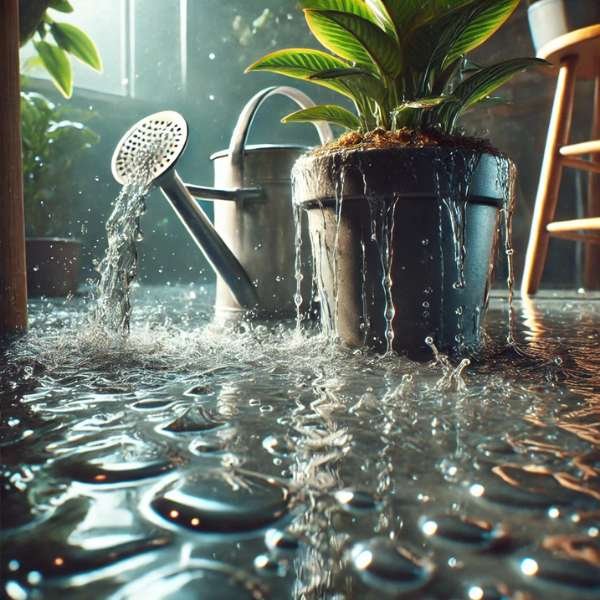
Overwatering. This is where it all goes wrong. Excess water starts to ooze out of the pot, messing up your surfaces, or worse, causing stagnant puddles that eventually lead to mold. Then there’s using the wrong tools—large cans that splash water all over, or simply forgetting to pay attention to what your plant truly needs. Without a solid plan, even something as basic as watering can morph into an unnecessarily complicated task.
Why It’s Important to Water Without Creating a Mess

Overflowing water doesn’t just leave behind a mess—it can wreak havoc on your furniture and floors. In damp conditions, water spills can invite mold and unwanted pests into your home. Keeping things clean isn’t just about aesthetics; it ensures your plants get just the right amount of water, promoting their healthy growth. A mess-free space means happy Vegetation and an even happier you.
Understanding Your Plants’ Watering Needs
How Often Should You Water Indoor Plants?

Different plants, different rules. Succulents? They love dry soil and might only need a drink every few weeks. Ferns? They prefer a more regular splash of water. The secret? Research! Learn about your plant’s natural habitat and mimic those conditions indoors. This helps you avoid both overwatering and underwatering disasters.
Identifying the Best Watering Schedule for Different Plants

No universal watering schedule exists, but here’s a trick: check the soil. For most Vegetations, let the top inch dry out before giving them more water. You can feel the soil with your fingers or invest in a moisture meter to avoid guesswork. Be flexible with the seasons too— Vegetations usually need more water during the warmer months and less during the colder season.
Choosing the Right Watering Tools
Watering Cans with Precision Spouts
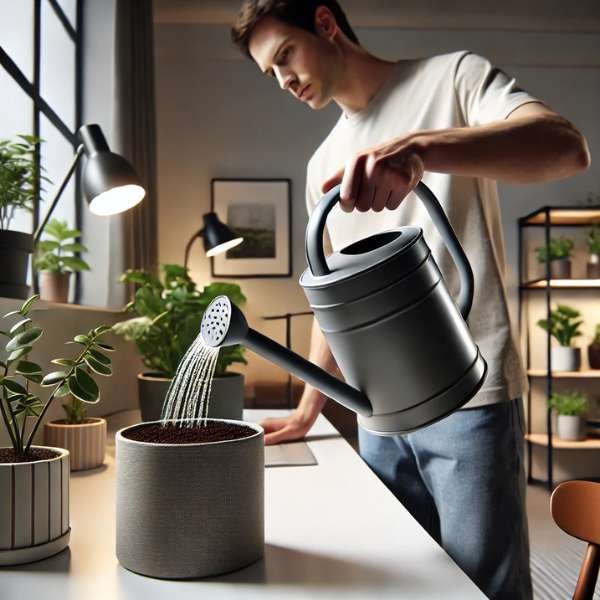
Indoor watering calls for precision. A narrow spout allows you to control where the water lands, preventing messy spills and ensuring deep soil saturation. Forget the bulky outdoor cans—they’ll cause more harm than good with their uncontrolled water flow.
The Benefits of Using a Self-Watering Pot
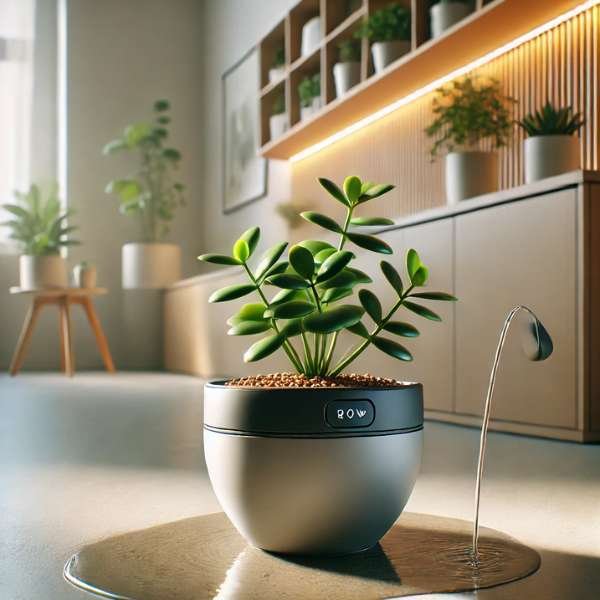
For beginner gardeners, self-watering pots are a game changer. These pots come with a built-in reservoir, letting the plant absorb water at its own pace. Not only does this prevent overwatering, but it also keeps your surfaces dry, making the whole process a breeze.
How a Plant Mister Can Help with Indoor Plant Care

Tropical plants often crave humidity over soil saturation. Enter the plant mister, which delivers just the right amount of moisture to the leaves without soaking the soil. It’s an efficient way to hydrate your Vegetation without the risk of overwatering the roots.
Preparing Your Indoor Space for Watering
Protecting Surfaces: Mats, Trays, and Towels

Preparation is key. Before watering, place protective mats or towels under your pots. Drip trays underneath Vegetation catch excess water, preventing spills and surface damage. Simple steps, big results.
The Best Places to Water Indoor Plants to Avoid Spills

Whenever possible, take your plants to the sink, bathtub, or even outdoors to water them. These safe zones eliminate the risk of damaging your indoor space. It’s a little extra effort but saves you time from cleaning up a mess afterward.
Why You Should Avoid Watering Directly on Furniture
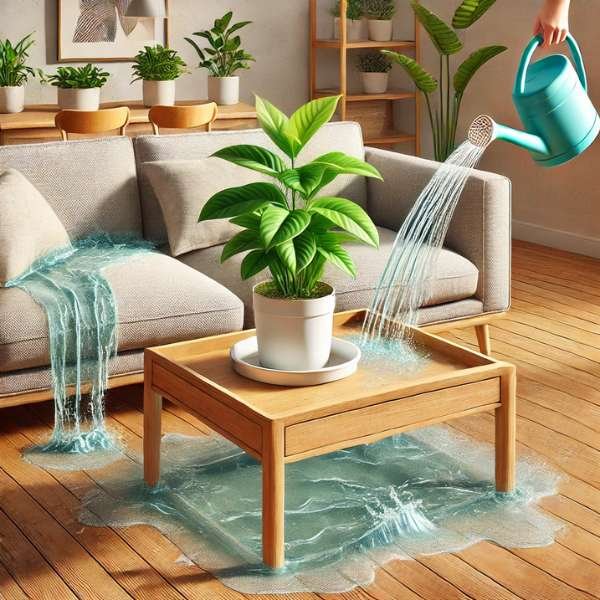
Water and furniture don’t mix. Wooden surfaces can warp, and fabric can trap moisture, leading to mold or bad odors. Always protect your furniture by moving vegetables or placing them on trays before watering.
The Right Watering Techniques
Watering from the Base: How and Why It Works

Instead of pouring water from the top, let your plant drink from the bottom. Place the pot in a shallow dish of water, and let the roots soak up what they need. This method encourages strong root development and keeps the soil surface neat and dry.
The Art of Top Watering: Tips for Controlled Water Flow

When you top-water, do it slowly and with care. Pour water around the edges of the pot to let the soil absorb it evenly. This avoids splashing and prevents water from rushing through the pot too quickly, ensuring even moisture distribution.
Using a Syringe or Bottle for Hard-to-Reach Plants

For tiny or hard-to-reach plants, a syringe or a small bottle can help control the water flow. This method gives you pinpoint accuracy and avoids unnecessary spills, keeping the process clean.
Catch Excess Water and Avoid Runoff
Using Drip Trays to Prevent Overflow

Drip trays are lifesavers for indoor gardeners. Placed under pots, they catch excess water and prevent it from spilling onto your floors or surfaces. Make sure to empty them regularly to avoid stagnant hydrate buildup.
The Role of Pebble Trays in Indoor Plant Watering

Pebble trays not only catch excess water but also help maintain humidity around the plant. By placing pots on a layer of pebbles and adding hydrate, you create a micro-humid environment that’s perfect for moisture-loving plants.
Choosing Pot Saucers That Fit and Function

Pot saucers do more than catch hydrate; they can also add a decorative touch to your plant display. Just make sure they’re wide enough to catch drips and sturdy enough to hold your plants.
Drainage Solutions to Prevent Mess
Why Proper Drainage Is Crucial for Indoor Plants

Good drainage ensures your plant roots don’t sit in hydrate, which can lead to rot. Always use pots with drainage holes to allow excess hydrate to escape.
How to Create a DIY Drainage System for Indoor Pots

No drainage holes? No problem. Create a layer of stones or broken pottery at the bottom of the pot to allow hydrate to pool underneath the soil. This helps keep the roots dry and healthy.
The Best Indoor Plants with Self-Draining Pots

Plants like snake plants or peace lilies often come in self-draining containers, which simplify the watering process. These built-in systems ensure hydrate doesn’t pool at the bottom, making them perfect for hassle-free care.
Watering Methods for Small Indoor Plants
How to Water Succulents and Cacti Without Overdoing It

Succulents and cacti need very little hydration. A spray bottle or small measuring cup works wonders for controlling how much hydrate you give them. Keeping the soil dry for extended periods is key to their survival.
Tips for Watering Herbs Indoors with No Spills

Indoor herbs, like basil or mint, thrive with consistent, light watering. Use a small watering can with a narrow spout to target hydrate at the base, preventing unwanted spills.
Watering Large Indoor Plants Without Making a Mess
The Best Ways to Water Trees and Tall Plants Indoors

Watering indoor trees can be a challenge. Use a watering can with an extended spout to reach the soil without disturbing the foliage. Consider placing a tarp or mat underneath to catch any runoff.
How to Move Large Plants for Watering Without Hassle

Transporting large plants can be tricky. Rolling plant stands make it easier to move them to a sink or outdoor area for a more thorough, mess-free watering session.
Handling Excess Water in the Soil
How to Know When Your Plants Are Overwatered

Yellowing leaves, soft stems, and soggy soil are all signs that you’ve gone overboard with watering. If you see these symptoms, stop watering immediately and let the soil dry out before resuming.
Solutions for Soggy Soil: Repotting and Fixes

If the soil remains too wet, consider repotting your plant with fresh, well-draining soil. Ensure the new pot has adequate drainage to prevent further issues.
Maintaining Humidity Without Overwatering
The Role of Humidity in Indoor Plant Health

Many plants, especially tropical ones, need higher humidity to thrive. But overwatering is not the solution. Mist the leaves or use a humidifier to keep moisture levels up without drenching the soil.
How to Use Humidifiers and Pebble Trays to Increase Moisture

Humidifiers help maintain the ideal moisture levels for your plants. Alternatively, pebble trays can create a humid micro-environment, especially for vegetarians who crave moisture.
Avoiding Common Watering Mistakes

Overwatering is the most common mistake in indoor gardening. Always check the soil before watering. If it’s still damp, hold off a few more days.
Overwatering: How to Tell if You’re Doing Too Much
Watering at the Wrong Time of Day: What You Need to Know
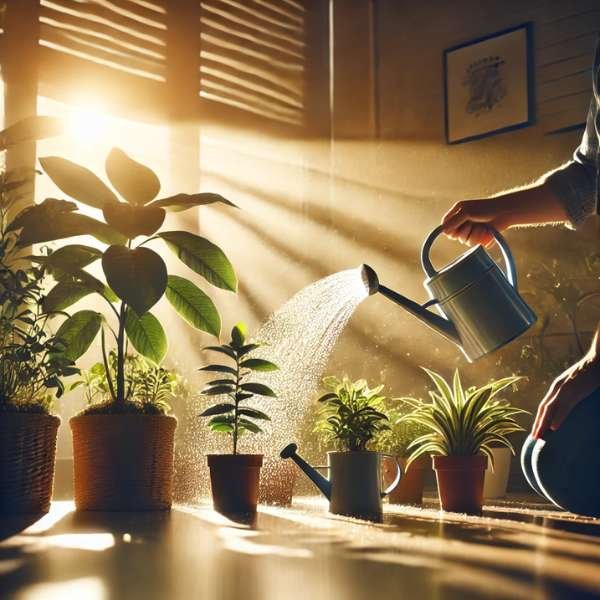
The best time to hydrate indoor plants is in the morning. This gives them a chance to absorb the hydrate and allows excess moisture to evaporate, reducing the risk of mold or pests.
How to Water While You’re Away
DIY Self-Watering Solutions for Short Trips

Heading out of town for a few days? Create a DIY self-watering system by placing a hydrate-filled bottle upside down in the soil. This slow-release method keeps your plants hydrated without overwatering.
Choosing the Best Automatic Watering Systems for Indoor Plants

For frequent travelers, an automatic watering system can be a game changer. These devices are programmable, ensuring your plants stay well-watered without the risk of overdoing it.
Cleaning Up After Watering
How to Quickly Absorb Water Spills from Plant Pots

Hydrate spills happen, but acting fast can prevent lasting damage. Keep absorbent towels handy to soak up any excess hydrate. For larger spills, a small wet vacuum works wonders.
Keeping Surfaces Clean and Protected After Watering

Waterproof mats or trays under your plants protect surfaces from damage. Regularly clean both to prevent mold and mineral buildup, keeping your plant area neat.
To treat abiotic disease in indoor plants, it’s important to hold smooth and guarded surfaces after watering. Watering can every now and then create damp conditions that sell fungal increase or entice pests. Wipe down surfaces with a gentle disinfectant to dispose of excess moisture and save you from contamination. Regularly cleansing pots, trays, and surrounding areas allows keep healthy surroundings for your flora.
Sustainable Watering Practices
Reusing Water for Indoor Plants: What Works and What Doesn’t

Recycle water when possible, but avoid using hydrate exposed to chemicals. Rainwater or cooled hydrate from boiled vegetables is packed with nutrients, making it great for vegetarians.
How to Conserve Water While Caring for Indoor Plants

Choose drought-tolerant Vegetation and use mulch on top of the soil to retain moisture, reducing how often you need to hydrate.
Top Indoor Plants That Are Easy to Water
Low-Maintenance Plants That Don’t Require Constant Watering

Snake plants, ZZ Vegetation, and spider Vegetation are low-maintenance heroes. These resilient vegetables don’t need much hydration and can survive an occasional missed session, making them ideal for busy schedules.
Indoor Plants That Thrive in Humid Conditions

Peace lilies, ferns, and calatheas love humidity and are perfect for homes with moisture in the air. These Vegetations thrive in a humid environment and are less prone to hydrate-related issues.
conclusion
Watering indoor plants without making a multitude is all approximately education and the right approach. By the use of the proper equipment and strategies, you may create a habit that maintains your own home and plant life in harmony. Not only will your indoor area remain tidy, but your vegetation will even flourish underneath your care. Remember, plant care ought to be an exciting enjoyment, no longer a chore. Take your time, take into account, and soon watering turns into a calming, pressure-free part of your day—bringing each of you and your flora a little more peace and balance.

